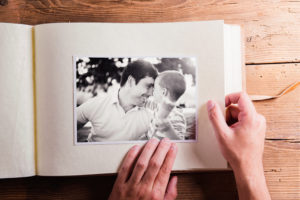You’ve probably heard of a baby book — that special blend of scrapbook and journal that allows parents to document every important step of their child’s first year or so of life. It’s a great idea, and they’re available for purchase at a variety of stores and, of course, all over the internet.
The problem with baby books, though, is that they don’t often include space for moments that are special to adoption. Adoption is no less special than growing your family the “traditional” way, and you deserve to commemorate the experience just as you would the birth of a biological child.
There are a few places to buy adoption memory books, or adoption “lifebooks.” But at American Adoptions, we occasionally like to get crafty; why not make your own? One of the special things about adoption is that the experience can vary so much from family to family. Creating your own adoption memory book allows you to tailor it to your own child. Plus, it’s a fun little project!
If you decide to create your own adoption memory book, here are some steps of the adoption process (chapters, if you will) you may want to include.
Before adoption. Start with some photos of your family before the adoption process. Write about why you decided to pursue adoption. You’ll want to keep the text simple, so your child will be able to go through and appreciate it as soon as he or she is old enough to read. For example, if you struggled with infertility, try something like: “Mommy and Daddy wanted you so much for such a long time, but nothing we tried was working. And then we decided to search for you through adoption.”
Meeting the birth parents. This one depends on your relationship with your child’s birth parents, of course. If you were able to meet them before placement, include any photos or memories you have from that time period. If not, see if you can get photos of the birth parents to include in this section. Talk about them as much as you feel comfortable. Write about how much they loved your child — enough to make sure they placed him or her with the right family, which was yours!
Hospital visit. If you were able to be there for your child’s birth, you’ll definitely want to include this in the adoption memory book. Use photos from the hospital, not only of you and your child, but of the birth parents as well. Include any special memories. Maybe there was a nurse that really went above and beyond, or maybe your child got to spend a few precious minutes with his or her biological mom right after birth.
After placement. This section should include all of the excitement you encountered when bringing your baby home. You might want to add photos of extended family members and friends meeting your child; you probably weren’t the only ones excited about his or her arrival! If you have older children, pictures of them meeting their new sibling are a must.
Finalization hearing. If you brought a camera along to the court hearing that finalized your child’s adoption, this is a great opportunity to showcase those pictures. “This is when you officially became stuck with us, kid!”
Birth parent relationship. If you have an open adoption, you’ll want to continue to include birth parent memories. Maybe this is photos of visits after placement, or maybe it’s snippets of letters or emails. If your child has other biological siblings, try to make sure they’re included as well.
At this point, your book is probably completely full. You now have a story that documents all phases of your child’s adoption, and all of the important people in his or her life. As you continue to take pictures and keep memories from his or her childhood, try to continue to include your child’s birth parents whenever possible. They don’t suddenly stop being important after placement; this is a relationship that will continue to enrich your child’s life as he or she grows. Remember, the more people that love your kid, the better!



